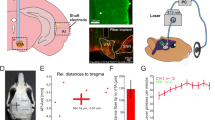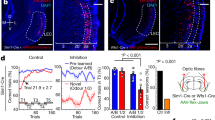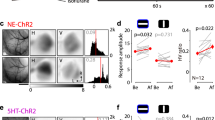Abstract
Representations of sensory stimuli in the cerebral cortex can undergo progressive remodelling according to the behavioural importance of the stimuli1,2. The cortex receives widespread projections from dopamine neurons in the ventral tegmental area (VTA)3,4,5, which are activated by new stimuli or unpredicted rewards6,7, and are believed to provide a reinforcement signal for such learning-related cortical reorganization8. In the primary auditory cortex (AI) dopamine release has been observed during auditory learning that remodels the sound-frequency representations9,10. Furthermore, dopamine modulates long-term potentiation11,12, a putative cellular mechanism underlying plasticity13. Here we show that stimulating the VTA together with an auditory stimulus of a particular tone increases the cortical area and selectivity of the neural responses to that sound stimulus in AI. Conversely, the AI representations of nearby sound frequencies are selectively decreased. Strong, sharply tuned responses to the paired tones also emerge in a second cortical area, whereas the same stimuli evoke only poor or non-selective responses in this second cortical field in naive animals. In addition, we found that strong long-range coherence of neuronal discharge emerges between AI and this secondary auditory cortical area.
This is a preview of subscription content, access via your institution
Access options
Subscribe to this journal
Receive 51 print issues and online access
$199.00 per year
only $3.90 per issue
Buy this article
- Purchase on Springer Link
- Instant access to full article PDF
Prices may be subject to local taxes which are calculated during checkout




Similar content being viewed by others
References
Buonomano, D. V. & Merzenich, M. M. Cortical plasticity: from synapses to maps. Annu. Rev. Neurosci. 21, 149–186 (1998).
Sanes, J. N. & Donoghue, J. P. Plasticity and primary motor cortex. Annu. Rev. Neurosci. 23, 393–415 (2000).
Foote, S. L. & Morrison, J. H. Extrathalamic modulation of cortical function. Annu. Rev. Neurosci. 10, 67–95 (1987).
Goldsmith, S. K. & Joyce, J. N. Dopamine D2 receptors are organized in bands in normal human temporal cortex. Neurosci. 74, 435–451 (1996).
Lidow, M. S., Goldman-Rakic, P. S., Gallager, D. W. & Rakic, P. Distribution of dopaminergic receptors in the primate cerebral cortex: quantitative autoradiographic analysis using (3H)raclopride, (3H)spiperone and (3H)SCH23390. Neruoscience 40, 657–671 (1991).
Hollerman, J. R. & Schultz, W. Dopamine neurons report an error in the temporal prediction of reward during learning. Nature Neurosci. 1, 304–309 (1998).
Schultz, W. & Dickinson, A. Neuronal coding of prediction errors. Annu. Rev. Neurosci. 23, 473–500 (2000).
Montague, P. R., Dayan, P. & Sejnowski, T. J. A framework for mesencephalic dopamine systems based on predictive Hebbian learning. J. Neurosci. 16, 1936–1947 (1996).
Stark, H. & Scheich, H. Dopaminergic and serotonergic neurotransmission systems are differentially involved in auditory cortex learning: a long-term microdialysis study of metabolites. J. Neurochem. 68, 691–697 (1997).
Bakin, J. S., South, D. A. & Weinberger, N. M. Induction of receptive field plasticity in the auditory cortex of the guinea pig during instrumental avoidance conditioning. Behav. Neurosci. 110, 905–913 (1996).
Gurden, H., Takita, M. & Jay, T. M. Essential role of D1 but not D2 receptors in the NMDA receptor-dependent long-term potentiation at hippocampal-prefrontal cortex synapses in vivo. J. Neurosci. 20, RC106, 1–5 (2000)..
Otmakhova, N. A. & Lisman, J. E. D1/D5 dopamine receptors inhibit depotentiation at CA1 synapses via cAMP-dependent mechanism. J. Neurosci. 18, 1270–1279 (1998).
Rioult-Pedotti, M.-S., Friedman, D. & Donoghue, J. P. Learning-induced LTP in neocortex. Science 290, 533–536 (2000).
Kilgard, M. P. & Merzenich, M. M. Cortical map reorganization enabled by nucleus basalis activity. Science 279, 1714–1718 (1998).
Zilles, K. in The Cerebral Cortex of the Rat (eds Kolb, B. & Tees, R. C.) 77–112 (MIT, Cambridge, Massachusetts, 1990).
Pandya, D. N. & Seltzer, B. Association areas of the cerebral cortex. Trends Neurosci. 5, 386–390 (1982).
Singer, W. Neuronal synchrony: a versatile code for the definition of relations? Neuron 24, 49–65 (1999).
Engel, A. K., König, P., Kreiter, A. K. & Singer, W. Interhemispheric synchronization of oscillatory neuronal responses in cat visual cortex. Science 252, 1177–1179 (1991).
Traub, R. D., Whittington, M. A., Stanford, I. M. & Jefferys, J. G. A mechanism for generation of long-range synchronous fast oscillations in the cortex. Nature 383, 621–624 (1996).
Oades, R. D. & Halliday, G. M. Ventral tegmental (A10) system: neurobiology. 1. Anatomy and connectivity. Brain Res. 434, 117–165 (1987).
Haring, J. H. & Wang, R. Y. The identification of some sources of afferent input to the rat nucleus basalis magnocellularis by retrograde transport of horseradish peroxidase. Brain Res. 366, 152–158 (1986).
Kilgard, M. P. & Merzenich, M. M. Plasticity of temporal information processing in the primary auditory cortex. Nature Neursci. 1, 727–731 (1998).
Bakin, J. S. & Weinberger, N. M. Induction of a physiological memory in the cerebral cortex by stimulation of the nucleus basalis. Proc. Natl Acad. Sci. USA 93, 11219–11224 (1996).
Van Essen, D. C., Anderson, C. H. & Felleman, D. J. Information processing in the primate visual system: an integrated systems perspective. Science 255, 419–423 (1992).
Tremblay, N., Warren, R. A. & Dykes, R. W. Electrophysiological studies of acetylcholine and the role of the basal forebrain in the somatosensory cortex of the cat. II. Cortical neurons excited by somatic stimuli. J. Neurophysiol. 64, 1212–1222 (1990).
Sachdev, R. N., Lu, S. M., Wiley, R. G. & Ebner, F. F. Role of the basal forebrain cholinergic projection in somatosensory cortical plasticity. J. Neurophysiol. 79, 3216–3228 (1998).
Jenkins, W. M., Merzenich, M. M., Ochs, M. T., Allard, T. & Guic-Robles, E. Functional reorganization of primary somatosensory cortex in adult owl monkeys after behaviorally controlled tactile stimulation. J. Neurophysiol. 63, 82–104 (1990).
Recanzone, G. H., Schreiner, C. E. & Merzenich, M. M. Plasticity in the frequency representation of primary auditory cortex following discrimination training in adult owl monkeys. J. Neurosci. 13, 87–103 (1993).
Nudo, R. J., Wise, B. M., SiFuentes, F. & Milliken, G. W. Neural substrates for the effects of rehabilitative training on motor recovery after ischemic infarct. Science 272, 1791–1794 (1996).
Diamond, D. M. & Weinberger, N. M. Classical conditioning rapidly induces specific changes in frequency receptive fields of single neurons in secondary and ventral ectosylvian auditory cortical fields. Brain Res. 372, 357–360 (1986).
Acknowledgements
We thank D. Blake for many informative suggestions; L. I. Zhang and F. Strata for discussions; and C. Garabedian and T. Moallem for comments on the manuscript. This work was supported by an NIH grant, the Coleman Fund, the Mental Insight Foundation, and Hearing Research.
Author information
Authors and Affiliations
Corresponding author
Supplementary information

Figure 1
(GIF 7.82 KB)
Tone exposure or VTA-stimulation alone does not change cortical topographic best-frequency map. Stimulation (ANOVA, p > 0.5). b, Percent of the auditory cortex that is tuned to each frequency band. No difference was found in a, The size of cortical area that was selectively responsive to pure tones was not changed by either tone exposure or VTA any of the eight frequency bands (p > 0.1).
Rights and permissions
About this article
Cite this article
Bao, S., Chan, V. & Merzenich, M. Cortical remodelling induced by activity of ventral tegmental dopamine neurons. Nature 412, 79–83 (2001). https://doi.org/10.1038/35083586
Received:
Accepted:
Issue Date:
DOI: https://doi.org/10.1038/35083586
This article is cited by
-
A bibliometric analysis of global research status and trends in neuromodulation techniques in the treatment of autism spectrum disorder
BMC Psychiatry (2023)
-
Hybrid graphene electrode for the diagnosis and treatment of epilepsy in free-moving animal models
NPG Asia Materials (2023)
-
Factors for optimizing intervention programs for cognition in older adults: the value of exergames
npj Aging (2023)
-
Individual differences in frontoparietal plasticity in humans
npj Science of Learning (2022)
-
The impact of video gaming on cognitive functioning of people with schizophrenia (GAME-S): study protocol of a randomised controlled trial
BMC Psychiatry (2021)
Comments
By submitting a comment you agree to abide by our Terms and Community Guidelines. If you find something abusive or that does not comply with our terms or guidelines please flag it as inappropriate.



